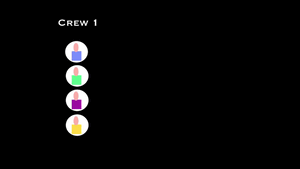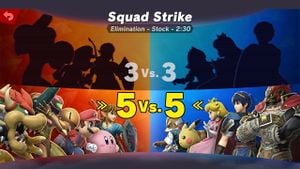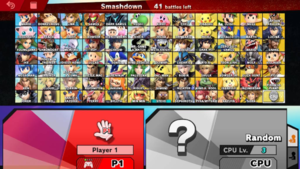Side events: Difference between revisions
LaughinElf (talk | contribs) mNo edit summary |
Tag: Mobile edit |
||
| Line 69: | Line 69: | ||
===Non-''Smash Bros.'' games=== | ===Non-''Smash Bros.'' games=== | ||
Some tournaments have either official or side events in other games outside of the ''Smash'' series. Usually such tournaments would play fighting games such as {{uv|Street Fighter}} or ''{{s|wikipedia|Marvel vs. Capcom}}'', or occasionally other platform fighters like ''Smash Bros.'' fan games and ''{{s|wikipedia|Rivals of Aether}}''. ''Smash'' tournaments are increasingly becoming fixtures at "traditional" fighting game events including prominent ones like [[CEO]]. | Some tournaments have either official or side events in other games outside of the ''Smash'' series. Usually such tournaments would play fighting games such as {{uv|Street Fighter}} or ''{{s|wikipedia|Marvel vs. Capcom}}'', or occasionally other platform fighters like ''Smash Bros.'' fan games and ''{{s|wikipedia|Rivals of Aether}}''. ''Smash'' tournaments are increasingly becoming fixtures at "traditional" fighting game events including prominent ones like [[CEO]]. The reverse situation also exists where some events that are primarily focused on "esports" games like ''{{s|wikipedia|League of Legends}}'' or ''{{s|wikipedia|Counter-Strike}}'' may include ''Smash'' tournaments. Such events have included [[Major League Gaming]], [[Press Start]], and [[DreamHack]]. | ||
==See also== | ==See also== | ||
Revision as of 14:21, November 6, 2023
Side events are events played on the side of a primary singles and/or doubles tournament. They are usually done for "fun", as well as to play under conditions that couldn't be done as its own standalone event, and to attract players who wouldn't attend for just the primary singles/doubles tournament. Due to the less serious nature, side events usually have a lower entry fee to enter and are often completely free.
Popular Formats
Crew battles
- Main article: Crew battle
Occasionally crew battles are run as an official side event, where they can either be two large crews competing, or an entire tournament of many crews. Crews are usually composed of members of preexisting crews, players from the same region, and recruited by a draft, where a team captain drafts other players for their crew. In the past, crew battle tournaments had entry fees and paid out the top placing crews. However, this practice largely ended around 2007.
Friendlies
A friendly is a match that takes place before or during a tournament but outside of any bracket, being for practice or just for fun in general. Friendlies normally have nothing but pride on the line, but players may compete in a money match instead, where an agreed upon amount of money is paid to the winner. Most money matches range between having 1 to 10 dollars on the line, but some have had players bet as high as 50, 100, or even 1,000 dollars. It's also not unheard of for players to put something non-monetary on the line, such as the loser doing push-ups or entering a tournament with a tag of the winner's choosing. Larger tournaments usually have dedicated areas hosting set-ups for friendlies.
Exhibition/Salty Suite
An exhibition is a featured set between two players who are usually of higher or top skill level. While the set is often a display of technical skill for the audience, it is typically played with the purpose of settling a feud between the two players, in which case it is colloquially referred as a Salty Suite. Notable streaming groups, such as VGBootCamp, have hosted these types of side events at tournaments such as Apex 2014 and Apex 2015. The salty suite between Leffen and Chillin during the latter tournament, would go on to be the most well known salty suite exhibition set within the greater Smash Bros. competititve scene. Some of these events will also often have additional wager on the line, such as money, or non-monetary wagers such as forbidding the loser from using a particular palette swap at future tournaments.
Combo Contest
A combo contest is an event where players perform the most impressive combo they can perform. The rules are typically any character can be used on any stage, and as many items as neccessary can be used. The combo is judged by a panel that typically rate the combo out of ten. The entrant that performed the combo with the highest average score wins. While any game in the series is capable of a combo contest, Super Smash Bros. has the most popular combo contest scene by a wide margin due to the game engine allowing for incredibly long combos.
amiibo Tournaments
Some Smash 4 and Ultimate tournaments have side events centered around amiibo. Players can enter their trained amiibo into brackets against other amiibo, with no human players actually taking part in the matches. Some tournaments allow amiibos to be fed equipment to alter the properties of their attacks or otherwise gain passive bonuses, though there are usually specific rules that dictate what kind and combination of equipment an amiibo can be fed to avoid overpowered entrants.
Squad Strike
- Main article: Squad Strike
Frequently Ultimate tourneys feature a Squad Strike bracket, sometimes even in the place of a Doubles bracket. These brackets are typically played in Tag Team mode, with players having three characters, and other rules mirroring what the tourney's normal Singles bracket uses. Often tournaments will have a rule that bans Echo Fighters from being used on the same team with their counterparts due to being too similar functionally to their parent character, though which Echoes fall under this ban varies from tourney to tourney; some tournaments may apply the ban to all Echoes, but will frequently exempt Ken, Chrom, and sometimes Lucina due to the more significant differences they have from their respective parent characters.
While crew battles can be run through Elimination mode, crew battles in Ultimate are typically ran outside the mode through the usual procedure that smashers have used in all other Smash games due to the fact that Elimination mode only allows one stock per character and doesn’t allow multiples of the same character per team while these are not limitations in a regular crew battle.
Smashdown
- Main article: Smashdown
Some Ultimate tourneys use the Smashdown mode, where everyone is forced to pick a new character every game until none are left. While picking a character for a game is usually done on the spot, some require players to reserve fighters ahead of time to avoid disputes where multiple players want the same fighter. Due to the way Smashdown works, only a maximum of eight players can be in a single tourney, and they all have to play every game. The player that takes the most KOs during the tourney is declared the winner. The tourney can also end early if the mercy rule is on.
Game mod tournaments
A common side event is a tournament played with one of the various game mods, primarily done to see how the mod plays under tournament conditions. Project+ and its predecessor Project M remain by and far away the most common game mods to be played at tournaments, to the point of developing its own tournament scene; Brawl- and Brawl+, however, also saw appearances at side events.Smash Remix, a 64 mod, has also developed a significant tournament following.
Modding Melee is significantly less convenient for the end-user because the Smash Stack exploit isn't available, thus fewer Melee mods have been developed. However, SD Remix is a balance mod that is somewhat popular and has side tournaments run for it.
Ultimate has also seen a steady increase of mod usage in tournaments, primarily through file replacement on the Yuzu emulator. However, there is comparatively little gameplay altering mods seeing regular use. Instead, the changes are mostly cosmetic, including new costumes, textures, and voice clips. A particularly popular type of mod is replacing the floor and wall textures of a stage with the logo of the tournament and/or a featured team.
Other Formats
Free for all
For a more casual-focused side event, sometimes tourneys may run a bracket that runs FFA matches instead of the standard singles and doubles. Exact rules beyond matches having four players vary, though typically a larger stage selection and items will be allowed too.
Amateur bracket
Players that fail to advance in pools, or who performed poorly in bracket (typically players who went 1-2 or 0-2, but sometimes even those that went 2-2), can be placed into an amateur bracket, to play additional matches without additional cost. Aside from getting to play extra matches, an amateur bracket gives lower level players the opportunity to compete in a tournament with players closer to their skill level that they can more realistically win. Amateur brackets are typically just ran as another double elimination bracket, but sometimes a round robin or ladder format may be used instead. Although it isn't always the case, there will frequently be some sort of prize for the winner of an amateur bracket, which will typically be some sort of merchandise, free entry to an upcoming tournament, a refund of the main tournament's entry free, or a simple small cash prize. Cash prizes are uncommon however, to discourage higher level players from intentionally losing early in the main tournament bracket in order to more easily profit from the amateur bracket.
Low and mid tier tournaments
A low tier tournament is a tournament that runs under standard rules, with the stipulation being players can only play low and bottom tier characters. What characters are considered "low tier" is at TO discretion. The main purpose of a low tier tournament is to play as characters under tournament conditions that would otherwise be rare in standard tournaments, as comparatively few players use such characters in tournaments, and even fewer players, such as Gimpyfish and Mekos, have been able to place decently at major tournaments with low tier characters. Sopo, or a single lead Ice Climber, is sometimes eligible for low-tier tournaments, as well as "Nolimar", Olimar without using any of his Pikmin.
A mid tier tournament is similar to a low tier tournament, except characters in the middle tiers can be played, with those in the top and high tiers being banned. What characters are considered "mid tier" is at TO discretion. The main purpose of mid tier tournaments is to have greater character variety than what a low tier tournament would allow, without having to see the abundance of top and high tier characters that dominate standard tournaments.
Special Smash
- Main article: Special Smash
Some side tourneys use the Special Smash mode to create custom games and rulesets. The official tournament ruleset is usually partially or entirely thrown out for these events, as they are not meant to be taken seriously and are more of a fun, low-stakes contest. Sometimes there is a prize pot for these events, but not very often.
All Brawl
All Brawl is a FFA ruleset that was a semi-popular side event back in the Brawl era, where players competed in 4-player FFA, with items on and every stage legal. The ruleset used for Apex 2012's All Brawl event was:
- Bracket used single elimination.
- 4 players per set.
- Stage choice set to random, every stage could appear
- Players had to pick random character for each match
- All items were set to have a medium probability of appearing
- First player to win 2 games advanced to the next round. 2nd person to advance was decided afterwards in the order of: games won, stock left in the last game, most KOs in the last game.
Non-Smash Bros. games
Some tournaments have either official or side events in other games outside of the Smash series. Usually such tournaments would play fighting games such as Street Fighter or Marvel vs. Capcom, or occasionally other platform fighters like Smash Bros. fan games and Rivals of Aether. Smash tournaments are increasingly becoming fixtures at "traditional" fighting game events including prominent ones like CEO. The reverse situation also exists where some events that are primarily focused on "esports" games like League of Legends or Counter-Strike may include Smash tournaments. Such events have included Major League Gaming, Press Start, and DreamHack.


